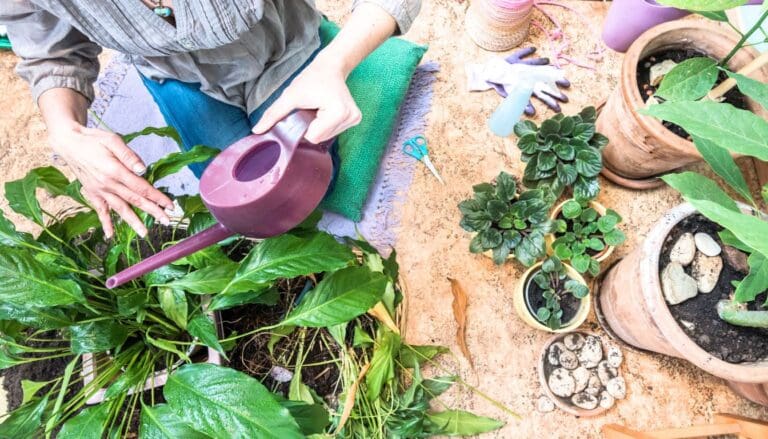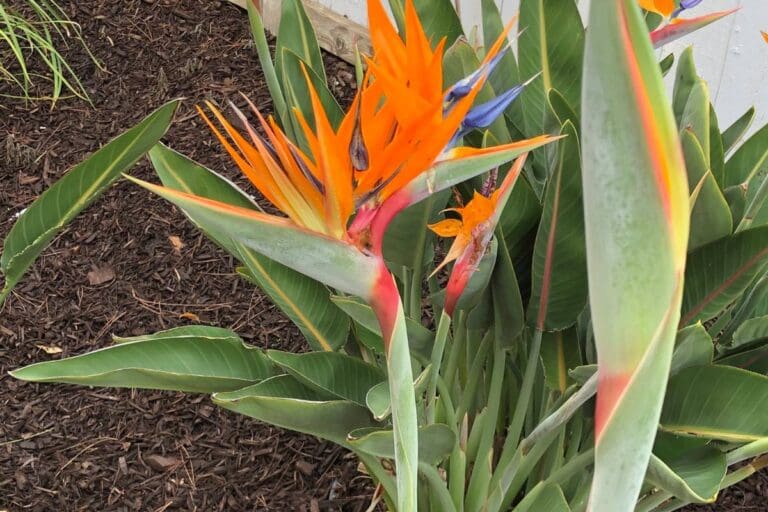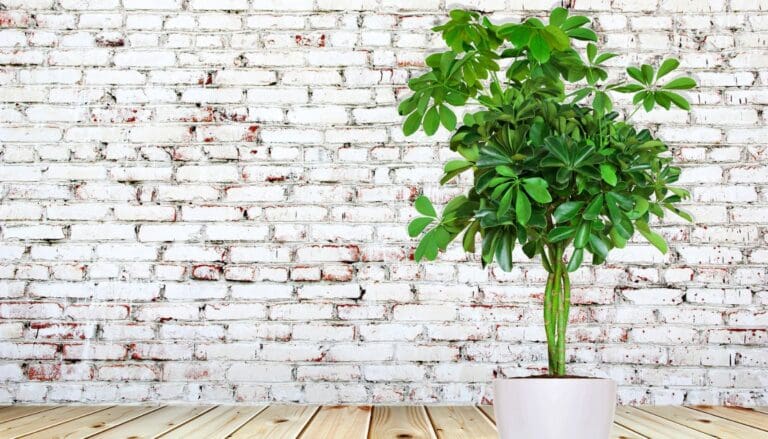Should I Mist My Calathea Plant? (Calathea Humidity Requirements)
Calatheas are beautiful tropical houseplants that, like any other tropical plant, prefer high humidity. While misting might be the first solution that comes to your mind, it might not be the best one.
So, in this article let us learn if Calathea likes to be misted or not? And how to maintain the right humidity levels for your calathea.
Calathes prefer to stay in a high humidity environment, and if you keep them at a place that doesn’t have enough humidity, then misting them 1-2 times a week will help. Apart from that, adding a humidifier, using a pebble tray, and grouping plants together can also help with humidity.
You can always mist your calathea, but you still need to opt for a long-term solution that can provide consistent humidity to the plant.
Misting has its pros and cons, and whether you should mist your calathea is what we will discuss in this article.

Please note: Simplify Plants is reader-supported. Some links in the post are affiliate links and I get a commission from purchases made through links in the post.
Do calathea like to be misted?
Yes, Calathea would appreciate some misting, especially if it doesn’t get sufficient humidity.
Coming from the tropical forests of the Amazon, Calathea is used to a lot of humidity that lets it thrive. Although you might not provide it as much, you should try to add as much humidity as possible inside your house.
Misting is the easiest way of providing instant humidity to your Calathea, which is why many people opt for it.
If you have a lot of time for your plants and can mist it multiple times a day, you won’t need any other way of adding humidity to your Calathea, but that doesn’t sound practical.
But misting your Calathea also has its share of benefits. So mist your Calathea whenever you can but don’t consider it the solution to its humidity requirements.
How many times a day should I mist calathea?
If your Calathea has no other way of receiving humidity, you would need to mist it regularly and maybe multiple times a day. This will ensure that the plant doesn’t run out of moisture after every few minutes.
But the question is, do you have so much time to mist it multiple times a day? If not, you need to consider an alternative and a long-term solution of providing humidity to your Calathea.
And if your Calathea is receiving the humidity it needs, you don’t need to mist it multiple times a day. You can mist it once a day or even once a week, based on your convenience.
Signs that your calathea requires more humidity

Calathea is a finicky plant, and understanding its requirements or figuring the right ways of growing it can be tricky.
But similar to most other houseplants, calathea will also show a few signs if it is not getting enough humidity.
Here are a few signs:
- Brown tips on leaves
- Entirely brown leaves
- Dry edges on leaves
- Curling leaves
- Stunted growth
These signs might also indicate other problems so before you conclude that low humidity is the issue, check the humidity levels of your house to be on the safe side.
You can measure the humidity of your house by using a hygrometer.
If the humidity levels are below 50%, your calathea is not getting enough, and it’s time for you to take action.
Does my calathea need a humidifier?
No wonder your calathea needs a humidifier.
If you haven’t heard about a humidifier, let me tell you, it might be one of the best equipment that can help your tropical plants, including Calathea, get the humidity it needs.
When we talked about a long-term solution that you can opt for instead of relying solely on misting, we talked about getting a humidifier.
A humidifier is capable of replicating the humidity levels of the tropical rainforests that your Calathea comes from.
Even if you don’t prefer as much humidity inside the house, the humidifier can provide the minimum humidity for the calathea to thrive.
A humidifier lets you adjust the humidity level you want. So you can get it installed in the same room as your tropical plants and set the level to provide sufficient humidity to them.
How do you give Calathea humidity?

I have already mentioned the humidifier, which I feel is the best way of adding humidity to the Calathea plants, but that’s not all.
If you cannot get a humidifier immediately, you can opt for any of these methods:
- Use a pebble tray.
- Take the plant to the kitchen or bathroom.
- Cover the plant.
- Place the plant near an aquarium.
- Group it with other tropical plants.
And let’s not forget that you can mist your Calathea along with these.
Create a pebble tray
Creating a pebble tray is common among plant owners who don’t have access to a humidifier. To create a pebble tray, all you need is a tray and some pebbles.
- Take the tray and spread the pebbles on it.
- Now, fill the tray halfway with water.
- Place the Calathea on top of the pebbles.
- As the water evaporates from the tray, it will increase the humidity around your Calathea.
You need to add water to the tray once you notice that the water level has gone down.
Relocate your calathea
Some rooms in your house have a higher humidity level than the rest. So, consider relocating your calathea to any of these rooms.
You can choose to shift the plant to the kitchen, bathroom, or basement, provided it will get all its other basic needs fulfilled in those rooms.
If you shift your calathea to the bathroom or kitchen, check if those rooms have enough light and aeration. If not, the plant will not remain healthy.
But if these places have everything your calathea needs, you can relocate the plant without any worry.
Cover your calathea
If you don’t have an option, you can cover your calathea with plastic wrap or a glass container.
Covering the plant might not be a long-term solution, but it is an effective way of boosting the humidity for your calathea.
Consider an aquarium
Did you know aquariums can provide humidity to your plants? Probably not. But that’s great news!
If you were planning on getting an aquarium, now you know it can also help your calathea or other tropical plants. And if you already have one, move your calathea near it.
When the aquarium’s water evaporates, it creates a high-humidity zone around it, so keeping the calathea in this zone will let it combat low humidity problems.
An added benefit of an aquarium is that you can use the nitrogen-rich water of the aquarium to water your calathea. This will boost the growth and act as a fertilizer.
So whenever you change the aquarium’s water, use it to water your plants instead of throwing it away.
Group it with other tropical plants

An easy way of increasing the humidity is to keep your calathea in the company of other tropical plants.
When the plants transpire, they release some moisture into the air. And when all the plants in the group do it, the small amounts of humidity add up and create a high humidity zone.
However, you need to be careful and inspect all the plants before you group them to ensure they don’t have any pest infestations or fungal infections.
Advantages and disadvantages of misting
Before you start missing your calathea, take a look at the possible risks and the advantages and then decide.
Advantages of misting
- First of all, misting is easy. You take some water in a spray bottle and spray on your calathea.
- Misting helps to clean the leaves. The leaves of the house plants collect dust every day. After you mist, wipe the leaves with a cloth to remove the dust and allow the leaves to breathe and photosynthesize better.
- Calatheas are prone to spider mite infestation. Misting helps to get rid of these pests as they do not enjoy moisture.
- Misting your calathea with Neem oil will also help prevent other pest infestations.
Disadvantages of misting
If you don’t do it right, misting can cause different problems for your calathea.
- Misting can encourage bacterial and fungal growth. It might also lead to the spread of these.
- Misting with poor quality water will be harmful to the leaves.
- Misting once or twice a day might not provide sufficient humidity to your calathea. The water might evaporate within half an hour and make the plant dry.
- If you are misting the soil, making it wet, you will notice fungal growth in it. You might come across fungus gnats too.
- If you are misting too often to provide sufficient humidity, the leaf surface might remain wet most of the time, due to which it will fail to transpire, leading to slow photosynthesis.
How to mist calathea?

By now, you must have acknowledged that you can mist the calathea plant, but you need to do it the right way.
Keep the following points in mind while misting your calathea plant.
- Don’t depend solely on misting to provide humidity to your calathea.
- Use any of the methods that we have mentioned above and mist the plant once a week.
- Do not mist your calathea with usual tap water as that may contain chlorine, fluorine, and bicarbonates harmful to the plant.
- Use distilled water or rainwater for misting your calathea.
- Add Neem oil to the water while misting calathea as it can prevent bug infestations.
- Don’t mist too frequently, as it can keep the leaves wet for longer than required.
- Don’t let the water reach the soil while misting, as it can cause fungal infections.
- Keep your calathea in an area that receives proper airflow as misting the plant placed in a damp area can lead to different issues.
- Mist the calathea upwards from the bottom. This will not affect the leaf growth of the plant.
- Try to mist using a fine spray bottle so that the water droplets can evaporate faster. This will not encourage bacterial or fungal growth.
Final thoughts
Before starting to mist your calathea, consider all its benefits and risks. If you opt for misting, do it the right way to get most of the benefits out of it.
If you are considering misting only to increase the humidity, consider an alternative such as installing a humidifier or grouping your calathea with other tropical plants. Misting is not a long-term solution to combating low humidity.
Don’t confuse misting with watering. Misting is not an alternative to watering. Water your calathea as per its requirements and mist the plant occasionally to reap its benefits.
Source: NCBI, University of Florida, Wikipedia, Growing Indoor Plants with Success, Agriculture, and Natural Resources, University of California, Missouri Botanical Garden.
Recommended Garden Supplies
| Product Image | Our Recommended Gardening Supplies | Check Offers! |
|---|---|---|
Top Top
Top
Top
Top
Top
Top
Top
Top | rePotme Houseplant and Tropical Classic Potting Soil Mix | Check Offer On Amazon |
 Top
Top
Top
Top
Top
Top
Top
Top | Espoma Organic Indoor Plant Food | Check Offer On Amazon |
 Top
Top
Top
Top
Top
Top
Top
Top | GooingTop LED Grow Light 6000K Full Spectrum Clip Plant Growing Lamp | Check Offer On Amazon |
 Top
Top
Top
Top
Top
Top
Top
Top | Soil Moisture Meter | Check Offer On Amazon |
 Top
Top
Top
Top
Top
Top
Top
Top | Govee Hygrometer Thermometer, Bluetooth Enabled! | Check Offer On Amazon |
 Top
Top | LEVOIT Humidifiers for Large Room(Best For Plants) | Check Offer On Amazon |
 Top
Top
Top
Top
Top
Top
Top
Top | Upgraded DIY Automatic Drip Irrigation Kit, 15 Potted Houseplants Support | Check Offer On Amazon |
 Top
Top
Top
Top
Top
Top
Top
Top | Stainless Steel Heavy Duty Gardening Tool Set | Check Offer On Amazon |
 Top
Top
Top
Top
Top
Top
Top
Top | Bonide Insecticidal Soap | Check Offer On Amazon |
 Top
Top
Top
Top
Top
Top
Top
Top | Bonide 32 oz Spray Neem Oil for Organic Gardening | Check Offer On Amazon |
 Top
Top
Top
Top
Top
Top
Top
Top | Garden Safe Fungicide | Check Offer On Amazon |






